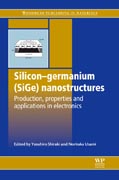
Silicon-germanium (SiGe) nanostructures: production, properties and applications in electronics
Shiraki, Y.
Usami, N.
Nanostructured silicon-germanium (SiGe) opens up the prospects of novel and enhanced electronic device performance, especially for semiconductor devices. Silicon-germanium (SiGe) nanostructures reviews the materials science of nanostructures and their properties and applications in different electronic devices. The introductory part one covers the structural properties of SiGe nanostructures, with a further chapter discussing electronic band structures of SiGe alloys. Part two concentrates on the formation of SiGe nanostructures, with chapters on different methods of crystal growth such as molecular beam epitaxy andchemical vapour deposition. This part also includes chapters covering strain engineering and modelling. Part three covers the material properties of SiGe nanostructures, including chapters on such topics as strain-induced defects, transport properties and microcavities and quantum cascade laser structures. In Part four, devices utilising SiGe alloys are discussed. Chapters cover ultra large scale integrated applications, MOSFETs and the use of SiGe in different types of transistors and optical devices. With its distinguished editors and team of international contributors, Silicongermanium (SiGe) nanostructures is a standard reference for researchers focusing on semiconductor devices and materials in industry and academia, particularly those interested in nanostructures. INDICE: Part 1 Introduction: Structural properties of silicon-germanium (SiGe) nanostructures; Electronic band structures of silicon-germanium (SiGe) alloys. Part 2 Formation of nanostructures: Understanding crystal growth mechanisms in silicon-germanium (SiGe) nanostructures; Types of silicon-germanium (SiGe) bulk crystal growth methods and their applications; Silicon germanium (SiGe) crystal growth using molecular beam epitaxy; Silicon germanium (SiGe) crystal growth using chemical vapour deposition; Strain engineering of silicon-germanium (SiGe) virtual substrates; Growing silicongermanium (SiGe) layers on thin silicon on insulator (SOI) substrate; Miscellaneous methods and materials for silicon-germanium (SiGe) crystal growth on thin films; Modelling the evolution of germanium islands on silicon(001) thin films; Strain engineering of silicon-germanium (SiGe) micro- and nanostructures. Part 3 Material properties of SiGe nanostructures: Self-diffusion and dopant diffusion in germanium (Ge) andsilicon-germanium (SiGe) alloys; Dislocations and other strain-induced defects in silicon-germanium (SiGe) nanostructures; Transport properties of SiGe nanostructures at low temperatures; Transport properties of SiGe nanostructures and applications in devices; Microcavities and quantum cascade laser structuresbased on silicongermanium (SiGe) nanostructures; Silicide and germanide technology for interconnections in ultra large scale integrated (ULSI) applications. Part 4 Devices using Si, Ge and SiGe alloys: Silicon-germanium (SiGe) heterojunction bipolar transistor (HBT) and bipolar complementary metal oxide semiconductor (BiCMOS) technologies; Silicongermanium (SiGe)-based field effect transistors (FET) and complementary metal oxide semiconductor (CMOS) technologies;High electron mobility germanium (Ge) metal oxide semiconductor field effect transistors (MOSFETs); Silicon and germanium in optical devices; Spintronics of nanostructured MnGe dilute magnetic semiconductor.
- ISBN: 978-1-84569-689-4
- Editorial: Woodhead
- Encuadernacion: Cartoné
- Páginas: 690
- Fecha Publicación: 01/01/2011
- Nº Volúmenes: 1
- Idioma: Inglés
